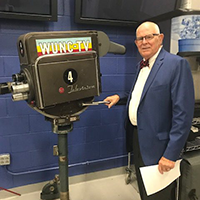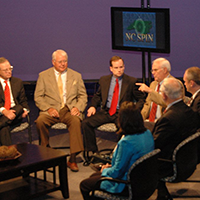New scoring test scale helps NC school students' scores
Published September 5, 2014
by Lynn Bonner and T. Keung Hui, News and Observer, September 4, 2014.
Public school students’ standardized test performance took a giant leap this year, largely helped along by a new scoring scale that makes the tests easier to pass.
The statewide overall passing rate in all subjects was 56.3 percent, compared with last year’s passing rate of 44.7 percent.
The results are based on standardized end-of-grade tests in reading and math in third through eighth grades, science tests for fifth- and eighth-graders, and end-of-course tests in three high school subjects.
The tests are based on Common Core standards in English and math and state standards in other subjects. After last year’s disappointing results using the long-standing 4-level scoring scale, the State Board of Education approved a new 5-level scale, making the tests easier to pass.
Though the test results have long been used to label schools and districts, they now carry even higher stakes. Third-graders who don’t pass the end-of-grade reading test risk being retained, and schools will be graded A-F for the first time, with the grades based on student scores.
The legislature, which mandated the new A-F system, directed the state Department of Public Instruction not to release the new grades until early next year. As it now stands, the grades do not carry any policy implications.
The overall passing rate was 66.6 percent in Wake, 44.2 percent in Durham, 77.1 percent in Chapel Hill-Carrboro, 59.6 percent in Orange County, and 58 percent in Johnston County.
Scores of 3, 4 or 5 are passing. Under the old system, passing scores were 3 and 4.
Under the new system, level 3 became level 4, and level 4 became level 5. Students who score at level 3 on the new scale are considered to be prepared for the next grade level, but not on track for careers or college, said Tammy Howard, director of the Accountability Division at the state Department of Public Instruction. With additional help, those students who score 3s will be ready for careers or higher education, she said.
Howard warned that direct comparisons could not be made between this year’s results and last year’s, given the new scoring scale. But she agreed to provide estimates of how students would have fallen on last year’s scale when pressed by two board members.
Board Vice Chairman A.L. Collins said he wanted more information on what a “3” score means.
“I think we need to be able to compare last year’s results to this year’s results to know how the descriptor works,” he said.
While state education administrators were hesitant to translate the scores into the more familiar scale, Wake County schools provided some context by looking back at what the 2012-13 scores would have been under the new grading scale.
Wake had a gain
Wake said that the district’s 2012-13 passing rate of 55.8 percent would have equaled 64.8 percent under the new scale. This meant that Wake saw what school officials called a steady gain of 1.8 percentage points in the passing rate this past school year to 66.6 percent.
“The increases that we’ve experienced really indicate that a great deal of hard work has gone into these results, and the dedication of our teachers is evident when you see those results,” Cathy Moore, Wake’s deputy superintendent for school performance, said at a news conference Thursday at Athens Drive High School in Raleigh.
Brad McMillen, Wake’s assistant superintendent for data, research and accountability, said since all schools would have seen a large bump from the change in standards, school officials wanted to accurately compare the results from the past two school years.
While Wake chose not to do so, other school districts used the new lower passing standards to say that they had seen big gains in performance. Charlotte-Mecklenburg issued a news release Thursday saying “gains ranged from nine to 18 points” on state exams.
Wake school leaders also noted how the district’s graduation rate rose 1.2 percentage points to 82.2 percent, the highest rate in the state’s largest district in eight years.
“Greater attention to individual student needs coupled with a focus on college and career readiness for our students continues to push our graduation rate steadily upward over time,” McMillen said. “We’re not where we need to be on that metric, but we are steadily improving.”
Wake’s four-year graduation rate was lower than the state rate of 83.8 percent. Durham’s graduation rate was 81.5 percent. Orange County Schools, the Chapel Hill-Carrboro district, and Johnston County Schools all had graduation rates higher than the state average, at 85.6 percent, 90.7 percent and 85.4 percent, respectively.
In addition to providing information to students, parents, teachers and the state, the test results are a major factor in state reports to the federal government on student achievement. Performance targets are set for schools as a whole and subgroups such as black students, white students, economically disadvantaged students, and so on.
Targets were set to gradually increase the portion of students who are proficient. About 21 percent of schools met all their targets. In DPI reports to the U.S. Department of Education, only scores of 4 and 5 are considered passing.
DATABASE EDITOR DAVID RAYNOR CONTRIBUTED.







